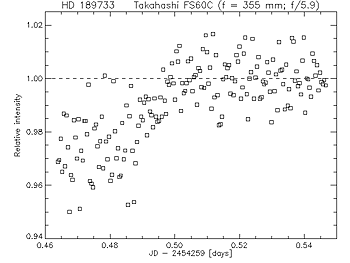Homepage of Michael Theusner
Exoplanets
Observing Exoplanet Transits with Limited Amateur Equipment
In May 2007, after obtaining a DMK firewire camera, I had the idea to observe exoplanet transits with my limited equipment (see below). After reading papers, some test and calculations, I came to the conclusion that this could indeed be possible with the brightest transit stars and the deepest minima. I chose HD 189733 for this purpose and developed IDL code for the light curve analysis. My first observation was on 2007-06-07. And it was a success! I could not quite believe it - but subsequent observations confirmed the reliability of my methodology. Unfortunately, the weather here prevents me from observing exoplanet transits more often...
This is the equiment used:
- Takahashi FS 60C
- DMK 31AF03.AS
So all it took was a 6 cm refractor and an uncooled 8-bit camera. I even did not have any guide control. But, some sophisticated data analysis revealed the dimming of the host star HD 189733.
For details, have a look at this PDF of a presentation I gave at the ESOP 2008 conference.
Informative publications on exoplanets Gary, B., 2007: "Exoplanet observing for Amateurs", e-book. Gives a good introduction into the matter. However, does not consider the possibility of using equipment as limited as mine. Perryman, M.A.C., 2000: "Review: Extra-Solar Planets". Rep. Prog. Phys., 63, 1209-1272. A nice overview on exoplanets in general, and possible advanced detection techniques. Mandel, K. and E. Agol, 2002: "Analytic Light Curves for Planetary Transit Searches". Astrophys. J. , 580, L171-L175. A more technical, though, highly interesting paper on transit light curve models. Pál, A., 2008: "Properties of analytic transit light curve models". Mon. Not. R. Astron. Soc. 390, 1, 281-288. Another technical paper describing advantages of using the Levenberg-Marquardt algorithm for transit light curve fitting. |
Exoplanet databases The Extrasolar Planets Encyclopaedia. An interactive catalog. Exoplanet transit time predictions provided by Transitsearch.
IDL code for transit light curve fitting Transit light curve modeling by Eric Agol (also in Python and Fortran). |
My Observations of HD 189733b Transits
The times given are all in UTC and mark the predicted start, center, and end of the transit.



